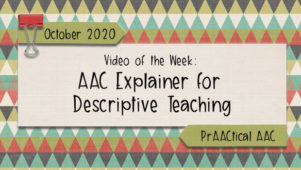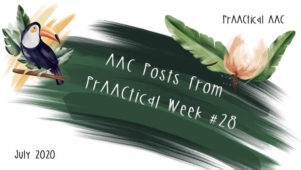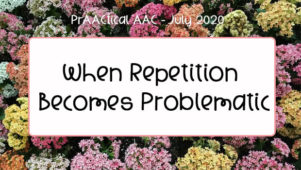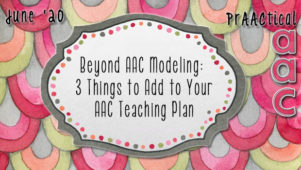AACtual Therapy: Using Aided Language Modeling
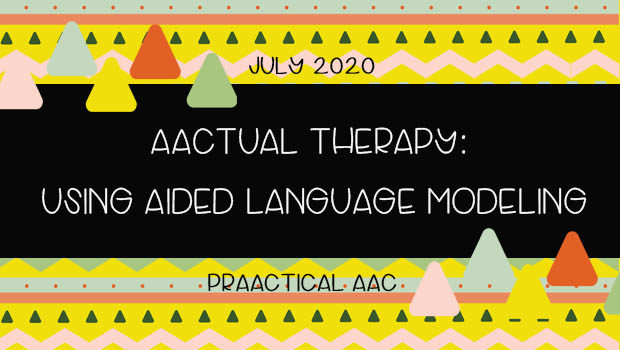
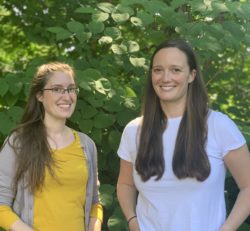 Although we’ve written extensively on the role of modeling in AAC, there are always new perspectives to consider regarding this evidence-based and widely-used strategy.
Although we’ve written extensively on the role of modeling in AAC, there are always new perspectives to consider regarding this evidence-based and widely-used strategy.
Today, we feature SLPs Kate Grandbois and Amy Wonkka who share their approach to aided language modeling.
::::::::::::::::::::::::::::::::::::::::::::::::::::::::::::::::::::::::
Bringing it all Together: Aided Language Modeling
Most SLPs working in AAC have come across a variety of different interventions in their practice. Some, like aided language modeling, are popular and commonly seen at conferences. They are the most popular option on the intervention buffet. Others, like discrete trial training, are like the mystery meat – you think you know what it is, you don’t think you’re going to like it, and you’re going to watch while someone else tries it first. Sometimes these teaching procedures are straightforward, and sometimes they are confusing, intimidating, or complicated. You may find that choosing which intervention to use is influenced by your goals, your workplace norms, or the direct needs of the AAC user; but when it comes down to actually implementing that intervention it can feel like a very complicated experience. What is the intervention supposed to look like? What materials should I use? What goals are going to be supported by this intervention? How am I possibly going to take data on this while I’m also trying to do therapy? Our goal for this series is to demystify some of the items in the intervention buffet and give a “how to” for implementation. We will touch on a wide variety of interventions seen in AAC, including aided language modeling, prompting procedures / prompt fading, incidental teaching vs discrete trial training, and finally shaping. First item on the buffet:
Aided Language Modeling
First, what is it?
Aided modeling interventions encompass a range of somewhat similar approaches that involve a communication partner providing some degree of input to an augmented communicator using an aided method. Aided modeling interventions are effective, evidence-based, and are becoming a common recommendation in the field of AAC (to learn more about the evidence and literature behind ALM you can listen to our episode on this). It can go by a variety of different names, including SAL, or system for augmenting language (Sevcik et. al. 1995), augmented input (Romski & Sevcik, 2003), aided language stimulation (Goossens’, 1989), aided language modeling (Drager et. al, 2006), AAC Modeling (Sennott, Light, & McNaughton, 2016), and natural aided language (Cafiero, 2001) to name a few. Bottom line: aided language modeling is a popular AAC intervention strategy that is evidence-based, but has a lot of individual variation depending on personal experience, setting, and AAC user goals.
So, any time I use the device to model, I’m providing ALM – right? Well, maybe. In their systematic review of the research, Sennott, Light, and McNaughton (2016) make this distinction between AAC modeling and instructional modeling:
The goal is that the adult “models” the expressive use of the child’s AAC system. AAC modeling is differentiated from instructional modeling, in that in instructional modeling the teacher models an instructional target. With AAC modeling, the teacher uses the AAC system in the context of a naturalistic communication interaction. A naturalistic communication interaction is defined as a “dynamic process between at least two people which is highly interactive, bi-directional, and multi-modal” (Kraat, 1985, p. 21) and occurs naturally in the context of the learner’s day (p. 2).
When you are thinking about introducing ALM strategies into your work, be sure to think about naturalistic communication exchanges that occur throughout your session or the client’s day. What types of things are they very interested in? What routines happen frequently? An awareness of these functional and naturalistic opportunities is important when integrating ALM into a treatment approach. Consider the importance of modeling within naturalistic exchanges – particularly those that are engaging and meaningful for your client – and finding opportunities to model a range of pragmatic functions (perhaps all with the same small set of vocabulary words) within those opportunities.
How do I use it? What does the intervention look like?
This is a great question – and the answer differs. Generally speaking, any intervention that involves aided language modeling will include some component of a communication partner providing input to an augmented communicator using something external to / other than their body (for a review of aided vs unaided communication methods, listen to our episode on AAC Basics and Terminology). Sennott et. al. (2016) emphasize the importance of a naturalistic context and interaction. What it actually looks like will depend on a lot of factors, it is driven by what the AAC user needs, but should also incorporate the needs of communication partners. Fortunately, the literature gives us some bumpers in the road to guide us. Binger and Light (2007) propose a recommended “dosage” of 30 models in a 15-min session. Additionally, Drager et al. (2006) recommend that when using a symbol and pointing to a referent there should be no more than a 2-s delay. This may sound intense. You may be asking yourself, “How am I supposed to model 30 models in 15 minutes when I am participating in the activity, focused on keeping my client engaged, and trying to hold a clipboard and take data at the same time???” We hear you, and so does every other clinician who has multi-tasked their way through a session with a complex learner. There are a variety of barriers to providing this ideal level of “dosage,” and the workaround to this is likely rooted in asking yourself what you can manage to model. We defer to Allen et al. who said:
“Overall, it is important for practicing clinicians to develop their own aided AAC modeling and ALM treatment protocols that meet the communicative needs of their cognitively and linguistically diverse clients.” (Allen et al. 2017 p. 156)
It’s important to know that when using aided language modeling it might look different when you do it vs. when your colleague does it. What matters is whether or not the intervention is working. Allen et al. agree, and state:
“Careful data tracking and analysis of language outcomes will allow clinicians to manipulate their treatment protocols in response to or lack of response to intervention.” (Allen et al. 2017 p. 156)
So, what does it look like? You may have to decide that for yourself and your client. Rest assured it’s OK if your style doesn’t match your colleague’s. Just be sure to match your rates of modeling with the linguistic and cognitive level of your client, be sure to do it in balance with other expectations in therapy, and take the data to back it up.
What should I do next?
Yeah, it’s big and intimidating to do a good job with this, but if you break it down into the small parts and tackle everything bit by bit it’s doable.
Step 1: Plan it
Consider your client’s overall strengths and areas of need such as attention, receptive and expressive language, sensory needs, and access methods. Then, think about the tasks that are relevant targets for your client such as: reciprocating a greeting at circle time, saying “that’s mine” to a peer, or learning new words and word combinations. Making a connection between all of these components will help in developing more meaningful targets for modeling. Be sure you are choosing targets that are interesting, motivating, and something they will come in contact with frequently. Finally, consider the environment: what are the variables that could influence how you model? Consider noise level, distractibility, and anything else in the environment that is relevant to your learner. Don’t forget that there are other ways to communicate too! The use of signs, gestures, or facial expressions should be something you consider – particularly if the person is physically able to use the gesture and it is frequently used by others (e.g., waving “hi”, shaking your head for “no”, etc.).
Action Item: Write it down. Everything is more manageable on paper. Write and organize these variables so you can see your plan and consider each factor and how they influence each other. Consider your client, the targets, the environment, and note any concerns you have. Make a list of accommodations you can make to the environment that could make modeling language more successful. Make a list of potential unaided or concrete aided supports (objects) you may also want to incorporate in your modeling intervention. Write it down in a table or graphic organizer that is available to you. If you don’t have one, use ours (see the example below; there is a blank version available for download here).
Step 2: Try it out
You don’t know what will work until you give it a try. You’ve planned it all out, thought through the important variables, and there’s only one way to find out if it will be effective! Bring your graphic organizer and notes. Take some extra time to modify the environment so you feel comfortable and set up for success.
Action Item: Use the information you generated during Clinical Action Step 1 and try those things with your client. Try them across multiple sessions. If you see them in different places or different types of environments, give those types of models a try in each place/activity. Take data to a degree that you are able, both quantitative and qualitative (to learn more about quality data collection see our data collection episode). We recommend taking data that can correspond to the specific planning and modifications that you did before the session (consider taking data on your planning document, or give this one a try). Make note of other observations and variables that are relevant.
Step 3: Review, Revise, Repeat
Review your data – did different things “work” better in different places? What physical arrangements worked or didn’t work? What did you learn from the implementation of ALM overall? Let your experience and data, both qualitative and quantitative, guide your decision making for how to move forward.
Step 4: Share it, Review, Revise, Repeat!
Define what you want others to do in clear, accessible language. Consider creating handouts, tables, or infographics to distribute to communication partners or as general visual supports for your classroom/clinic/etc. Provide models, training or other supports as needed. Check in with communication partners and make it clear that their feedback is important too!
Action Item: Gather information from communication partners. There may be barriers to getting input from others (scheduling conflicts, etc.), consider different ways that you could get the information you need such as having a personal conversation, using a checklist they can fill out (see an example here!), or a more formal data collection process. Start small, so communication partners and your clients feel successful and supported. Review all the components mentioned in Step 3, incorporating the input from others to modify as needed whenever there are challenges or whenever your client has achieved new skills and is ready for more!
To learn more about aided modeling interventions, we encourage you to check out the references listed below. Overall, aided modeling intervention is a strategy that can benefit both the communicator and their partners. By modeling, communication partners are likely to become more familiar with vocabulary that is currently in, or may need to be added to, an aided AAC system. Partners may use slower rates of speech, and/or become more aware of target vocabulary, morphological, or syntactic structures. In summary, when you are planning your approach to modeling, think about factors connected with the who (the student/client), the what (their activity/task), and the where (environmental and communication partner features). There is no one, universal “right way” to provide aided input. Individualizing your approach may feel like a big task, but by breaking down the components into small parts, reflecting, and revising you will continue to refine what is successful for you as a clinician, your individual clients, and their unique communication partners.
Check SLP Nerdcast for an upcoming episode that corresponds to this article.
References
Allen, A., Schlosser, R., Brock, K., Shane, H. (2017). The effectiveness of aided augmented input techniques for persons with developmental disabilities: a systematic review. Augmentative Alternative Communication, 33(3), 149-159.
Binger, C., & Light, J. (2007). The effect of aided AAC modeling on the expression of multi-symbol messages by preschoolers who use AAC. Augmentative and Alternative Communication, 23(1), 30–43. doi: 10.1080/07434610600807470.
Cafiero, J. M. (2001). The effect of an augmentative communication intervention on the communication, behavior, and academic program of an adolescent with autism. Focus on Autism and Other Developmental Disabilities, 16(3), 179–189. doi: 10.1177/108835760101600306.
Drager, D. R., Postal, V. J., Carrolus, L., Castellano, M., Gagliano, C., & Glynn, J. (2006). The effect of aided language modeling on symbol comprehension and production in 2 preschoolers with autism. American Journal of Speech-Language Pathology, 15(2), 112-125.
Goossens,’ C. (1989). Aided communication intervention before assessment: a case study of a child with cerebral palsy. Augmentative and Alternative Communication, 5(1), 14–26. doi: 10.1080/07434618912331274926.
Kraat, A. W. (1985). Communication interaction between aided and natural speakers: A state of the art report. Madison, WI: Trace Center Reprint Service. Retrieved from http://www.eric.ed.gov/ERICWebPortal/contentde-livery/servlet/ERICServlet?accno=ED287275
Romski M.A., & Sevcik R.A. (2003). Augmented input: Enhancing communication development. In Light JC, Beukelman DR, Reichle J, editors. Communicative competence for individuals who use AAC: From research to effective practice. Baltimore, MD: Paul H. Brookes; 2003. pp. 147–162.
Sennott, S. C., Light, J. C., & McNaughton, D. (2016). AAC modeling intervention research review. Research and Practice for Persons with Severe Disabilities, 41(2), 101-115. https://doi.org/10.1177/1540796916638822
Sevcik, R. A., Romski, M. A., Watkins, R. V., & Deffebach, K. P. (1995). Adult partner-augmented communication input to youth with mental retardation using the System for Augmenting Language (SAL). Journal of Speech, Language, and Hearing Research, 38(4), 902–912. doi: 10.1044/jshr.3804.902
About the Guest Authors
Amy Wonkka: Amy has worked as a speech-language pathologist in the Northeast and Midwest. Prior to becoming an SLP she worked for several years as a 1:1 paraprofessional and home service provider for individuals with complex communication needs. She has experience in home-based, public school, nonpublic school, and outpatient environments. Amy’s clinical interests include augmentative and alternative communication (AAC), autism and other related needs, typical language development, motor speech, phonology, data collection, collaboration, coaching, and communication partner training and support.
Kate Grandbois: Kate is a dually certified SLP / BCBA with 13 years of clinical experience working in private practice, outpatient clinics, outpatient hospital settings, and consulting to private schools and legal teams. She specializes in augmentative alternative communication, autism and associated disorders, language development, and integrating AAC into the educational/vocational programming of persons with behavioral needs. Her private practice, Grandbois Therapy + Consulting, LLC, focuses on multidisciplinary treatment, collaboration, and mentorship. She has served as an advisory board member for the HP Hacking Autism Initiative, as adjunct faculty at Northeastern University, and is the former president and co-founder of The Speech and Language Network, Inc.
Filed under: Featured Posts, PrAACtical Thinking
Tagged With: aided communication, Aided Language Input/Stimulation, Language facilitation strategies
This post was written by Carole Zangari

